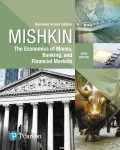
To Explain: The reason why the self-correcting mechanism becomes non-operational when the policy rate hits the zero-lower bound
Concept Introduction
Zero-Lower Bound: The nominal rate of interest has some lower bound. It cannot fall beyond that point. Realistically the nominal rate of interest can be slightly negative as depositors may agree to pay the bank a small amount for keeping their money safe or for providing the convenience of quick money. But for the sake of simplicity of theoretical analysis, it has been assumed by the economists that nominal interest rate cannot be negative. If the central bank finds that the desired real interest rate needs a negative nominal rate of interest, it will set the nominal interest rate to zero. This is known as zero lower bound.
Want to see the full answer?
Check out a sample textbook solution
Chapter 24 Solutions
EBK ECONOMICS OF MONEY, BANKING AND FIN

 Principles of Economics (12th Edition)EconomicsISBN:9780134078779Author:Karl E. Case, Ray C. Fair, Sharon E. OsterPublisher:PEARSON
Principles of Economics (12th Edition)EconomicsISBN:9780134078779Author:Karl E. Case, Ray C. Fair, Sharon E. OsterPublisher:PEARSON Engineering Economy (17th Edition)EconomicsISBN:9780134870069Author:William G. Sullivan, Elin M. Wicks, C. Patrick KoellingPublisher:PEARSON
Engineering Economy (17th Edition)EconomicsISBN:9780134870069Author:William G. Sullivan, Elin M. Wicks, C. Patrick KoellingPublisher:PEARSON Principles of Economics (MindTap Course List)EconomicsISBN:9781305585126Author:N. Gregory MankiwPublisher:Cengage Learning
Principles of Economics (MindTap Course List)EconomicsISBN:9781305585126Author:N. Gregory MankiwPublisher:Cengage Learning Managerial Economics: A Problem Solving ApproachEconomicsISBN:9781337106665Author:Luke M. Froeb, Brian T. McCann, Michael R. Ward, Mike ShorPublisher:Cengage Learning
Managerial Economics: A Problem Solving ApproachEconomicsISBN:9781337106665Author:Luke M. Froeb, Brian T. McCann, Michael R. Ward, Mike ShorPublisher:Cengage Learning Managerial Economics & Business Strategy (Mcgraw-...EconomicsISBN:9781259290619Author:Michael Baye, Jeff PrincePublisher:McGraw-Hill Education
Managerial Economics & Business Strategy (Mcgraw-...EconomicsISBN:9781259290619Author:Michael Baye, Jeff PrincePublisher:McGraw-Hill Education





